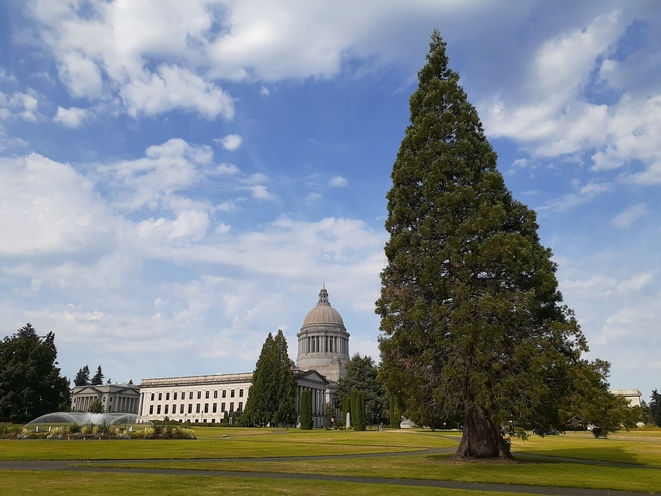
Rain or shine, spring, summer or fall, a walk among the trees does a body good. We stare up at their heights with awe through a winding kaleidoscope of branches and leaves. Many have stood through storms, persevered with development, provided shelter over the years and witnessed the passing decades of our city. Olympia has its share of great trees just waiting for passersby to wonder at their respected age and their stories. Take a walk around Olympia and check out these famous historic trees.
 Garry Oak
Garry Oak
Boundary Street SE and Legion Way
Some trees have one root in the past and one in the present. One particular Garry oak is doing just that. The story goes that as a seedling the oak was brought by saddleback from Steilacoom. It was planted by Dudley (Dud) Story Bradstreet Henry and his wife, Fanny, in 1872 on their homestead, which is now an East Olympia neighborhood. D.S.B. Henry was a second-generation surveyor and civil engineer and son of Anson Henry, who was a friend of Abraham Lincoln. The Henry family came west by wagon train when Dudley was 10 years old. The Garry oak, commonly referred to as the Oregon white oak, perhaps gets its label from the Garry in its Latin name Quercus garryana. First United Methodist Church of Olympia, at the corner of Boundary Street SE and Legion Way, is now the steward of this relic.
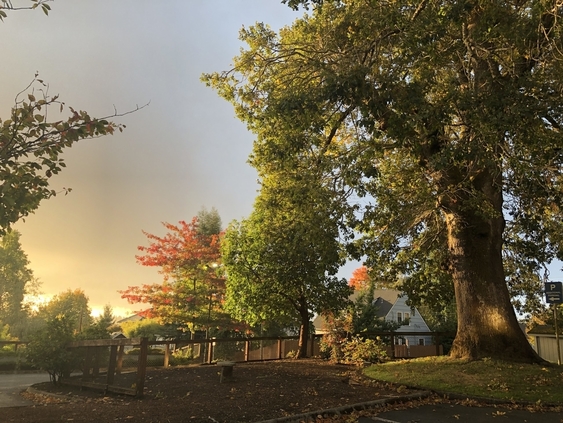
Centennial Sequoia
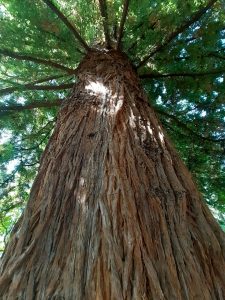
Union Avenue between Jefferson Street SE and Washington Street SE
Another landmark stands in Centennial Park, closer to downtown Olympia. A 131-year-old sequoia is tucked away in this small park on land that previously belonged to Rossell O’Brien, an Irish, Civil War veteran who came to Olympia in 1870. O’Brien is known for having started the custom of standing for the “Star-Spangled Banner.” During a meeting of the Loyal Legion in Tacoma, in October of 1893, O’Brien stood during the national anthem, beginning the long lasting custom.
The Sequoia sempervirens was planted on the O’Brien property around the time Washington reached statehood in 1889 and was determined to be 100 years old near the centennial anniversary of statehood, thus earning the park its name. The sequoia has officially been named the Daniel J. Evans Sequoia to honor one of Washington’s former governor’s environmental protection work. The O’Brien house and those adjacent are no longer present. The park is a portion of the city block along Union Avenue between Jefferson Street SE and Washington Street SE.
Moon Tree
Capitol Way and the South Diagonal Street
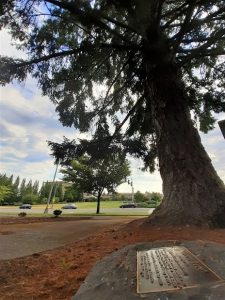
The Moon Tree on the Washington State Capitol campus has been on a mission to the moon. Hundreds of tree seeds, including those of the Pacific Northwest native the Douglas fir, took a ride into space and back. The Apollo 14 mission launched on January 31, 1971, and along with it went 400-500 tree seeds. Astronaut and former U.S. Forest Service smoke jumper Stuart Roosa brought the seeds along as part of a NASA/USFS project. Roosa and the seeds remained in the Kitty Hawk command module, orbiting above the moon while Alan Shepard and Edgar Mitchell landed on the lunar surface. The Douglas fir seeds, one of five types chosen for the mission, were planted as part of the bicentennial celebrations in 1976. The Moon Tree is located at the corner of Capitol Way and the South Diagonal Street on the Capitol campus.
The Lone Tree
Legend has it that in 1792 Robert Gray, captain of the of the Columbia Rediviva, sailed into Gray’s Harbor with the aide of a lone spruce tree visible in the distance. Located on Damon Point near Ocean Shores, the Daughters of the American Revolution installed a plaque at the tree. A storm in the 1930s damaged the tree, but the plaque and a limb were saved. The Washington Historical Quarterly reported in 1935 that a Mrs. H.W. Paton was able to retrieve the broken limbs and gave them as a specimen to the University of Washington. A seedling was created from the remains of the original, legendary Lone Tree, and it was planted along the front walkway at the old State Capitol Museum building at 211 SW 21st Avenue in Olympia.
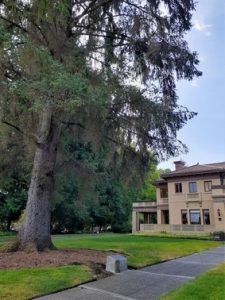
Olympia has woven together its conservation and urban forestry efforts with its appreciation of local history and people. The City of Olympia’s Landmark Trees are defined in the Olympia Municipal Code as “a tree or group of trees designated as such by the city because of its exceptional value to the residents of the city. Value is determined by factors such as: association with historic figures, events or properties, rare or unusual species, or exceptional aesthetic quality.” For 27 years, Olympia has been a Tree City USA city, a program with the Arbor Day Foundation that equips cities with a framework to manage their trees through protective ordinances, expenditure plans, celebrations and creating a board to oversee the steps. The city’s Department of Urban Forestry cares for the city’s flora and fauna, manages plans for the future and educates the public.
Throughout Olympia neighborhood streets stand trees that are living memorials to those who planted them, in some cases more than a century ago, and are witnesses that bridge the span of time. We can walk and stand in the shelter of these trees, be humbled by their grandeur and learn about Olympia’s history.


















































